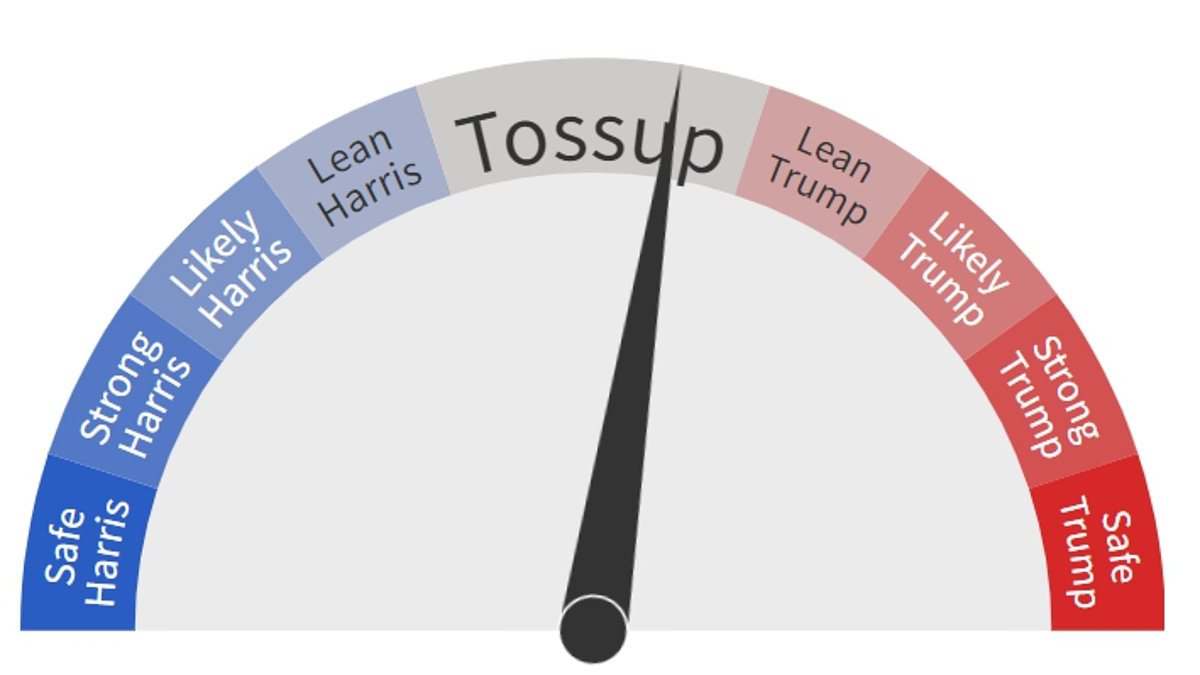We are headed for the closest election in decades. With everything potentially coming down to a few thousand votes in key states, the election has never been more uncertain.
That’s why it is more important than ever to be able to sort the polling cream from the crop.
Enter the Daily Mail/J.L. Partners prediction model. Taking our experience in modeling elections across the globe and the U.S. we have developed a model to take on the race for the White House.
Here’s how it works, and why we believe it is the best in the business.
It starts with a ‘fundamentals’ model. This predicts how many votes each candidate will win given historical data. This model has two parts–the long-term model and the short-term model.
The long-term part uses presidential election data from the past 76 years to estimate the vote shares. We take account of which party is in power, economic data, and presidential approval ratings.
All of these factors then give us an initial estimate of the final vote shares. For example, if Biden’s approval ratings are low then this will reduce the prior vote share of Harris.
But this history alone isn’t enough. We dive deeper into elections since 1996.
The US political environment has become more polarized during the past 30 years and our short-term model reflects that. We add variables such as Consumer Confidence and Congressional Approval to form our Short-Term Fundamentals.
For example, if confidence in the economy has fallen over the past year then this will hurt the incumbent’s prior vote share.
We combine these two estimates to get our best guess, given history alone, of the vote shares each candidate might win.
This gives us an historical picture but it doesn’t take into account the contours of 2024. To do that we also gather all of the polls conducted across the country, at state and national level.
Compared to other models, we only use polls that use full-ballot testing. That’s because third party candidates—from R.F.K. Jr. to Jill Stein—matter a lot.
In 2000, Green Party candidate Ralph Nader got more votes than the margin between George Bush and Al Gore. Jill Stein’s votes arguably cost Hillary Clinton the 2016 election, amounting to more than Trump’s winning margin in Michigan, Wisconsin and Pennsylvania.
We then do something else. Not every third-party candidate has access to the ballot in every state. We use our independent research to determine how votes flow from these third-party candidates to the two main contenders – answering the question of how their supporters would vote if they weren’t on the ballot. This is done for every state
So our model can properly account for the impact third-party candidates have on the race.
That unique algorithm ends up helping Trump in states where RFK Jr isn’t on the ballot, but Jill Stein and Cornel West – who take more support from Harris – are.
We also give less weight in our model to polls that are of just adults or registered voters rather than likely voters, and a poll’s contribution to the model is weighted in accordance to a pollster’s historical accuracy.
Additionally, we downweight online-only polls that lack rigorous methodology for verifying their interviewees’ identities and matching them to the voter file. Instead, we give more weight to polls that use mixed method approaches or have robust methodology – like the Daily Mail’s.
The final step is the most technical part. We use a highly sophisticated autoregressive Bayesian algorithm, continuously updating our predictions with real-time data from states and national polls. We make crucial adjustments to reflect who is on the ballot in each state, producing an accurate, up-to-date picture of the nation’s voting intentions.
Let’s be clear: any pollster telling you with certainty what is going to happen in this election is selling you moonshine. But we believe our model – that synthesises both historical trends and current polling, and accounts for third-party effects – gets the closest to reality.
This election, skip the guesswork, or dodgy partisan takes. The Daily Mail/J.L. Partners model is your best bet for seeing where the real battle lines are drawn.
The authors are: Callum Hunter, Data Scientist at J.L. Partners, in London; Landon Wall, modeling and analytics partner, in Arizona; James Johnson, co-founder, in Washington
